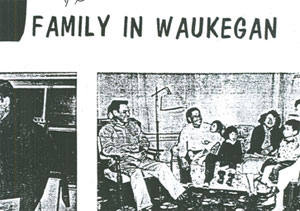
The U.S. government's efforts to assimilate American Indians into mainstream culture can be seen throughout the 20th century in the Bureau of Indian Affairs (BIA) activities. In 1953, the U.S. Congress established a new policy towards American Indians: termination. This policy eliminated much government support for Indian tribes and ended the protected trust status of all Indian-owned lands.
In response to this policy, the BIA began a voluntary urban relocation program. American Indians could move from their rural tribes to metropolitan areas such as Chicago, Denver, Los Angeles, Cleveland, and Seattle. BIA pledged assistance with locating housing and employment. Numerous American Indians made the move to cities. They struggled to adjust to life in a metropolis and faced unemployment, low-end jobs, discrimination, homesickness and the loss the traditional cultural supports. The urban relocation program changed the face of cities as well as American Indian culture. American Indians, who returned to the reservation often, found they did not "fit in" with those who stayed behind. When BIA urban relocation efforts started nearly eight percent of American Indians lived in cities. The 2000 Census noted that American Indian population had risen to approximately sixty-four percent.
The Chicago Field Office Employment Assistance Case Files contain memorandums and progress reports, as well as promotional devices used to recruit Indians on reservations. To comply with privacy exemptions found in the Freedom of Information Act (FOIA) 5 U.S.C. 552, the names of individuals has been covered up for classroom use. The Chicago BIA Relocation Field Office created and distributed the suburban posters after the Chicagoland poster.
Record Group 75, Records of the Bureau of Indian Affairs, Chicago Field Office Employment Assistance Case Files, 1952-1960.

Suburban Poster, Chicago Field Office Employment Assistance Case Files, 1952-1960, Record Group 75, Records of the Bureau of Indian Affairs.

Field Office Poster-Chicagoland, Chicago Field Office Employment Assistance Case Files, 1952-1960, Record Group 75, Records of the Bureau of Indian Affairs.
Encourage students to explore through National Archives records life on reservations and in major cities during the 1950s. Focus specifically on the tribes listed on the posters. What would motivate American Indians to leave their communities and move to a major city? What social issues were prevalent in cities, such as Chicago during the 1950s?
Write a letter in the voice of one of the members listed on either poster to relatives living on the reservation about experiences in Chicago.
Using other National Archives resources, chart the relationship the Federal government had with American Indians.
National History Standards
Era 9: Postwar United States (1945-1970s)
This page was last reviewed on March 3, 2023.
Contact us with questions or comments.